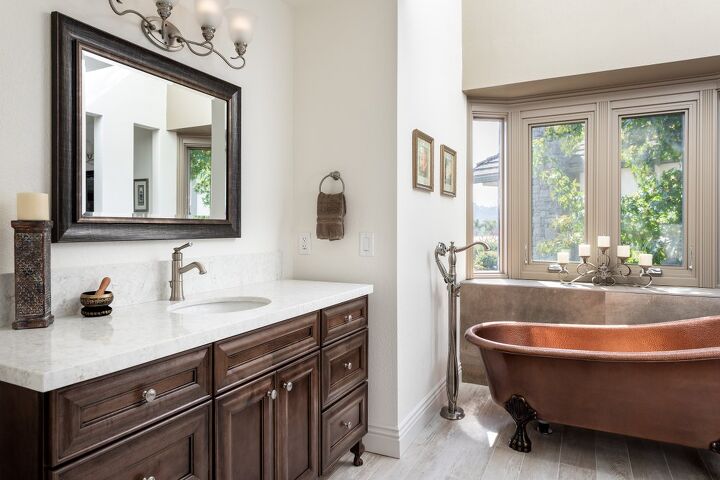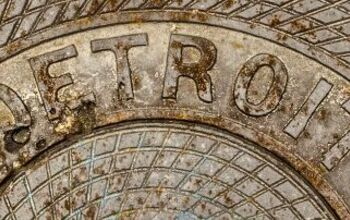What Are The Pros And Cons Copper Bathtubs?

What could be more luxurious than soaking in a copper bathtub? It seems like the height of sophistication. And because of the amazing properties of copper, the material makes for a tub that’s both unique in style and durability.
Highly resistant to dents and scratches, copper bathtubs have a long lifespan. The natural antibacterial properties of copper make the tub a hygienic environment. Copper bathtubs are eco-friendly, low-maintenance, and offer multiple health benefits. However, they aren’t mass-produced and tend to be one of the most expensive tubs available. High-quality copper tubs range from $2500-$10,000 or more.
Do You Need Bathtub Installation or Replacement?
Get free, zero-commitment quotes from pro contractors near you.

Sophisticated Style
Languishing in a bathtub is its own form of luxury. Doing so in one made of copper adds a whole other level of sophistication.
With the unique beauty of a copper bathtub, you transform your bathroom into an elegant oasis. A copper tub brings warmth to the space with its vibrant color. Due to the natural formation of patina, the tub will gain a gloss or sheen over time, adding even more vibrancy.
Durability
Copper is a highly durable metal, though still malleable enough to mold into any shape. During the molding process, other materials have a tendency to crack. This is not the case for copper. The durability of a copper tub is proved in its making.
The tub’s surface is resistant to dents and scratches. Due to the patina changing the tub’s color, any scratches that do occur disappear on their own over time. Unlike other tub materials, copper bathtubs have a long lifespan because of the material’s durability.
Hygiene and Safety
If there’s any place for good hygiene practices, it’s in a bathroom. Some people can’t tolerate the idea of sitting in a bath for that very purpose. But you don’t have to worry about germs in a copper bathtub.
Copper has natural antibacterial properties which ensure the tub stays hygienic and mold-free. Studies show bacteria can’t live on copper for more than a few hours. Other surfaces, such as stainless steel, can hold bacteria for days.
Because the surface can remain germ-free, copper tubs promote cleaner water than other tub materials. This means you can safely soak in it as long as you please.
If made from pure copper, the tub is perfectly safe. Lower quality copper tubs sometimes contain unsafe levels of mercury or lead not suitable for bathing. You want the material to consist of 97% copper or more.
Eco-Friendly
Because copper is a recyclable material, it’s an environmentally-friendly choice for a bathtub. Not only that, but copper has amazing heat retention, keeping the water warmer for longer. If you want to soak, you won’t have to keep adding hot water. This reduces your water use and saves on your energy bill.
Low-Maintenance
Their durability and hygienic surface mean copper bathtubs are relatively low-maintenance. They don’t require all those harsh chemicals and antibacterial cleaners. In fact, you shouldn’t use chemicals at all at the risk of damaging the surface.
To keep a copper bathtub clean, you need only to wipe it occasionally with a dry cloth after use.
Cost of Copper Bathtubs
With everything, there is a downside, and unfortunately for copper tubs, it’s their cost. Copper bathtubs are considered one of if not the most expensive tubs on the market. Their construction requires expert craftsmanship which drives up the price.
Copper bathtubs are not mass-produced, so custom orders are needed to procure one. And custom orders equal high price tags. High-quality copper tubs range from $2,500-$3,000. Depending on size, style, and features, they can be upwards of $35,000.
It’s likely that the tub requires an online order since it’s difficult to find in stores. Therefore, shipping and handling must also be added to the overall cost.
Cost by Size
A small tub is typically 55 or 60 inches in length and costs around $2,500.
A medium tub is typically 64-68 inches and ranges in price from $5,000-$7,000.
A large tub is typically 70-75 inches and ranges in price from $7,500-$10,000 or more.
Because of their custom nature, copper tubs can be ordered in any size, though 70 inches is considered the largest on the market. But with custom sizes come higher prices.
Style Variety
A custom design is not without its benefits. Copper tubs can be made to fit any size and style your heart desires. The following are a few of the most popular styles of copper tubs:
- Freestanding bathtubs are your classic bathtub style. Modern versions have a completely level base. This allows the tub to support larger volumes and capacities of water than a drop-in tub.
- Clawfoot tubs get their name because they sit off the floor on legs with clawed feet. They are a variant of the freestanding tub and fit a more traditional style.
- Soaking tubs are built to hold a large volume of water so their users can fully submerge.
- Japanese bathtubs support large volumes of water while at the same time boasting a smaller size. This makes them a suitable alternative for smaller bathrooms.
Gauging Quality
The thickness of the copper is of the utmost importance. The gauge of copper determines the thickness and thus the quality of the tub. A higher-numbered gauge means the copper is thinner. It’s best to avoid 20-gauge copper and choose instead copper that’s gauged 16 or lower.
Thinner copper dents more easily and has a tendency to leak. The thicker the copper the longer its lifespan.
Copper Bathtub Health Benefits
In addition to its hygienic surface, copper bathtubs also have other amazing health benefits.
- They have restorative effects on both connective tissue and joint movements. They reduce inflammation caused by tendonitis, arthritis, osteoporosis, and other illnesses. Each time you come in contact with the tub’s surface, your body absorbs small amounts of copper. This acts as an anti-inflammatory without the gastrointestinal side effects.
- Copper assists in developing collagen which is what reduces wrinkles. It’s found in many anti-aging products. When the copper from the tub absorbs into your body, you also absorb its anti-aging benefits.
- Additionally, copper holds many other skincare benefits. Taking a bath in a copper tub may help keep your skin moisturized, reduce skin irritation, and heal wounds. These benefits are the reason many skincare products include copper.
Copper Bathtub Pros and Cons
Check out this table which summarizes the pros and cons of copper bathtubs.
| Pros | Cons |
| Highly durable with a long lifespan | One of the most expensive tub materials available |
| Promotes a hygienic environment | Not sold commercially. Online orders add shipping and handling to an already high price tag. |
| Multiple health benefits, which include reduction of inflammation and wrinkles | Lower quality tubs may contain unsafe levels of mercury and lead |
| Eco-friendly and low-maintenance | Patina changes look over time |
Related Questions
We’ve covered a lot in our discussion about the pros and cons of copper bathtubs. But perhaps you have more questions. Below are some things other people wondered about copper bathtubs.
Can you use bath salts in copper tubs?It’s an unfortunate downside, but both bath salts and Epsom salt should not be used in a copper bathtub. They may corrode and tarnish the copper’s surface.
Certain brands, like the William Holland Copper Bath, have a protective coating that allows for the use of salts and oils. The coating also protects it from patina. However, unless you’re positive this coating exists on your tub, it’s not recommended to use bath salts.
What can I use to clean a copper bath?Copper tubs don’t require much to keep them clean. This is due in part to the natural antibacterial qualities of copper. After use, a simple wipe-down of the surface with a dry cloth is all that’s needed. This keeps water spots from forming. For a more thorough cleaning, use gentle dish soap and wipe with a soft sponge or cloth.
Do you have to polish a copper bath?Polishing and waxing are not required for a copper bath. They will stay shiny on their own because of the patina. If you want to stop the patina at a certain point, you can apply copper wax, beeswax, or furniture polish. This will slow the patina’s progression. Once you’re satisfied with the outcome, apply a clear lacquer to the surface to preserve the patina.
Do You Need Bathtub Installation or Replacement?
Get free, zero-commitment quotes from pro contractors near you.

Summing It Up
Really, the only downfall of the copper bathtub is its high price tag. Ranging anywhere from $2,500 to upwards of $10,000, copper tubs are definitely not in everyone’s budget. They are also tricky to get a hold of, often requiring custom online orders. But if you’re able to look past that very large expense, you’ll see that copper bathtubs have many amazing qualities.
Sitting in one is akin to taking medication and applying the best skincare products. The natural health benefits of copper include antibacterial and anti-inflammatory qualities.
The material is eco-friendly and highly durable. It retains heat for a warmer bath that uses less water and energy. And it won’t dent or scratch with repeated use.
Elegant and sophisticated, copper bathtubs bring a warmth and vibrancy that are unmatched by other bathtub materials.

Brigid Levi is a wife, mother, and freelance writer who enjoys a good DIY project and creating beautiful spaces within her home. From cleaning and organization hacks to home decor ideas, she loves helping people in their quest to turn a house into a home. Her hobbies include pretending to be Joanna Gaines while updating her home with her husband and performing in local theater productions.
More by Brigid Levi



























